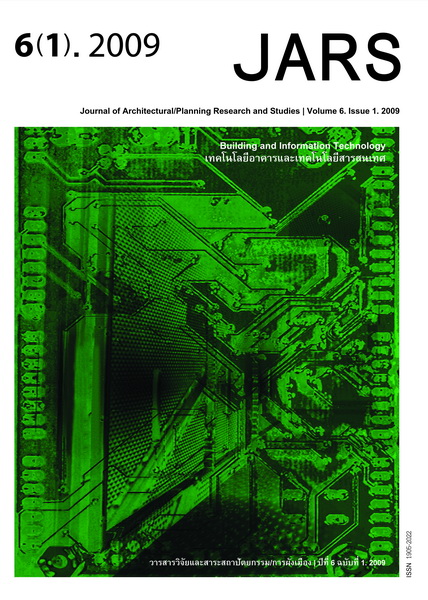Predicting Airflow in Naturally-ventilated Generic Houses
Main Article Content
Abstract
This article reports the results of continuing research into the impact of the opening orientation and
opening size on the natural ventilation of generic detached houses. The CFD simulation of 72 ventilation cases
is generalized from actual houses surveyed in the suburban areas of Bangkok. It is discovered that larger
opening in general allows higher indoor air velocities than smaller opening. In most cases, the Venturi effect
proves to be efficient in terms of indoor air velocities up to approximately 1:1.5 proportion of inlet to outlet
opening area. In terms of air distribution, it is found that the opening size and the ratio of inlet to outlet opening
area do not have much impact on the uniformity in small square rooms. In large rectangular rooms, the Venturi
effect improves the uniformity in two- and three-sided ventilation cases. In cross ventilation cases, however, the
uniformity depends on the opening size. The results lead to the prediction of airflow and comfort which is
demonstrated by an example of application on an actual building.
Downloads
Article Details

This work is licensed under a Creative Commons Attribution-NonCommercial-NoDerivatives 4.0 International License.
All material is licensed under the terms of the Creative Commons Attribution 4.0 International (CC-BY-NC-ND 4.0) License, unless otherwise stated. As such, authors are free to share, copy, and redistribute the material in any medium or format. The authors must give appropriate credit, provide a link to the license, and indicate if changes were made. The authors may do so in any reasonable manner, but not in any way that suggests the licensor endorses you or your use. The authors may not use the material for commercial purposes. If the authors remix, transform, or build upon the material, they may not distribute the modified material, unless permission is obtained from JARS. Final, accepted versions of the paper may be posted on third party repositories, provided appropriate acknowledgement to the original source is clearly noted.
References
Auliciems, A. (1981). Towards a psycho-physiological model of thermal perceptions. International Journal of Biochemistry, 25, 109-122.
CHAM. (2008). PHOENICS 2008. London: Author.
Chen, Q., & Srebric, J. (2001). How to verify, validate, and report indoor environment modeling CFD analysis, ASHRAE RP-1133. Atlanta, GA: ASHRAE.
Chenvidyakarn, T. (2007). Passive design for thermal comfort in hot humid climates. Journal of Architectural/Planning Research and Studies, 5(1), 3-27.
Ernest, D., Bauman, F., & Arens E. A. (1991). The prediction of indoor air motion for occupant cooling in naturally ventilated buildings. ASHRAE Transactions, 97, 539-552.
Gagge, A. P., Fobelets, A. P., & Berglund, L. G. (1986). A standard predictive index of human response to the thermal environment. ASHRAE Transactions, 92(2), 709-731.
Givoni, B. (1994). Passive and low energy cooling of buildings. New York: John Wiley & Sons.
Givoni, B. (1998). Climate considerations in building and urban design. New York: Van Nostrand Reinhold.
Hu, C., & Wang, F. (2005). Using a CFD approach for a study of street-level wind in a built-up area. Building and Environment, 40, 615-631.
Jitkhajornwanich, K. (2006). สภาวะสบาย และการปรับตัวเพื่ออยู่แบบสบายของคนในท้องถิ่น [Thermal comfort and adaptation for thermal comfort of local populations]. The 2006 National Research Council of Thailand Award. Bangkok, Thailand, 117-120.
Sreshthaputra, A., Haberl, J., & Andrews, M. J. (2004). Improving building design and operation of a Thai Buddhist temple. Energy and Buildings, 36, 481-494.
Szokolay, S. V. (2004). Introduction to architectural science: The basis of sustainable design. Oxford, UK: Architectural Press.
Tantasavasdi, C., Jareemit, D., Suwanchaiskul, A., & Naklada, T. (2007). Evaluation and design of natural ventilation for houses in Thailand. Journal of Architectural/Planning Research and Studies, 5(1), 85-98.
US Department of Energy. (2009). Statistics for THA_Bangkok_IWEC. Retrieved September 1, 2009, from http://apps1.eere.energy.gov/buildings/energyplus/weatherdata/2_asia_wmo_region_2/THA_Bangkok_IWEC.stat


